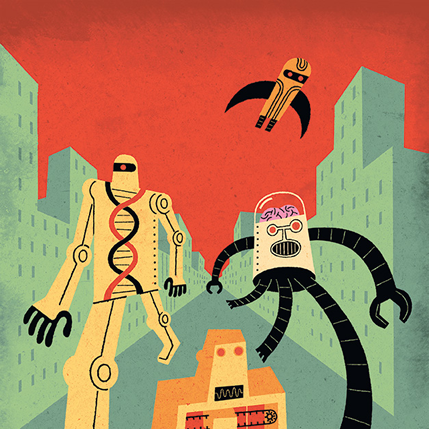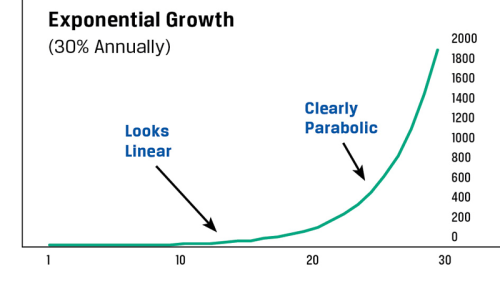Great.
From the CFA Institute's Enterprising Investor blog:

Something amazing this way comes. An invasion fleet of perennial “next big things” that have disappointed futurists (for decades in some cases) and provided ammunition for skeptics is finally set to arrive. Artificial intelligence, robots, biotech, and several other world changers are about to create entire new growth-stock ecosystems while disrupting a range of established industries — not someday, not maybe, but definitely, and starting now.
To understand this approaching wave of creative destruction, two basic concepts are helpful: exponentiality and simplification. First, on exponentiality, humans tend to think in linear terms. That is, we notice a rising trend generated by the early stages of steady growth but don’t extrapolate to the point at which progress will go parabolic (if it continues at the same rate). As Ray Kurzweil, noted inventor, author, and now Google’s director of engineering, told a Singularity University audience in August 2014, “People tend to dismiss a disruptive technology when it’s only 1% of a solution, ignoring the fact that it’s doubling every few years and will be at 100% in a very short time.”
Second, on simplification, it’s important to understand that in many cases, the real disruption will come not from bigger, “badder” machines but from simpler, smaller ones. “A typical high-end sports car like a Mercedes S550 has around 1,600 moving parts; a Tesla [electric car] drive train has 19,” says Alex Daley, editor of Casey Extraordinary Technology newsletter in Stowe, Vermont. “A Predator drone is far simpler to build and maintain than an F-35 fighter jet. Big, single-purpose manufacturing robots are being supplanted by fundamentally simpler 3D printers. At every point in the manufacturing process, the steps are being simplified and digitized, as software replaces hardware.”
Rise of the Machines
Consider two examples of what happens when exponential improvement and radical simplification intersect: artificial intelligence (AI) and robotics.
Computers are (perhaps thankfully) a long way from being conscious. But they are becoming intelligent. IBM supercomputers Deep Blue and Watson have, respectively, outplayed the reigning human champions of chess and the game show Jeopardy. And Google and Amazon certainly seem like brainy entities to their users. This kind of AI is spreading to pretty much everything, automating what can be automated and augmenting what (for now) cannot. Amazon warehouses use fleets of robots that locate items and bring them to a central packing station, cutting the time it takes to box a typical order from 1.5 hours to 15 minutes. Spanish food processor El Dulze uses robots to evaluate heads of lettuce, reject substandard specimens, and position the good ones for processing by other machines. Google’s driverless vehicles had, by the end of 2014, driven 800,000 miles without an accident. And pilotless drones are replacing everything from fighter jets to traffic helicopters to spy satellites. The list continues through burger-flipping robots and semiautomated clothing stores to encompass virtually every manufacturing and transactional service niche.

In addition to AI and robotics, three other key areas figure to be the focus of intense development: 3D printing, expert systems, and “the internet of things.”
- 3D Printing. Thirty years ago, an engineer named Charles W. Hull invented a process called “additive manufacturing,” which involved building objects layer by layer rather than through molding or cutting. It was slow and expensive and required decades of incremental improvements to escape the lab. But escape it has. Today’s 3D printers can build objects of startling complexity from a set of digital blueprints, and the price/performance ratio is falling exponentially. Entry-level versions now cost less than US$1,000, and the range of things they can produce has expanded to include electronic components and human replacement organs.
- Expert Systems. In December 2014, internet phone company Skype debuted a feature that translates conversations between English and Spanish in near real time. Stanford University’s PaleoDeepDive “machine reading system” has equaled scientists at extracting and organizing data from scientific journals. And IBM is turning its Watson AI into a cloud-based utility that will dispense smarts the way an electric utility provides power. Oncologists at New York’s Memorial Sloan Kettering Cancer Center currently use Watson to improve diagnoses and treatment.
The Disrupters and the Disrupted
- The Internet of Things. According to the 2013 McKinsey & Company report Disruptive Technologies: Advances That Will Transform Life, Business, and the Global Economy, “More than nine billion devices around the world are currently connected to the Internet, including computers and smart phones. That number is expected to increase to between 50 billion and one trillion in the coming decade.” The trend is proliferating. Take ever-smaller, more sophisticated sensors and microelectromechanical systems; embed them in appliances, buildings, and clothing; and imbue them with cloud-based artificial intelligence. “Everything will have its own IP address and will communicate with everything else,” predicts Jim Mellon, UK money manager and author of Fast Forward: The Technologies and Companies Shaping Our Future. The result is not just a world of smart devices but a smart environment that understands the spoken word and behaves in ways that simulate volition and judgment.
3D printing is being pioneered by a range of companies, from tech giants such as Hewlett-Packard and Autodesk to newcomers Stratasys, 3D Systems, and MakerBot. But most other AI and robotics breakthroughs are either emanating from or being snapped up by established players. “The best virtual reality company is owned by Facebook,” says Mellon. “Google recently bought Boston Dynamics, probably the best robot company in the world apart from FANUC in Japan. Now they’re a leader in robotics as well as drones, bioinformatics, and wearable devices.” In effect, he contends, one could think of Google as a very long-term robotics/AI fund....MUCH MORE